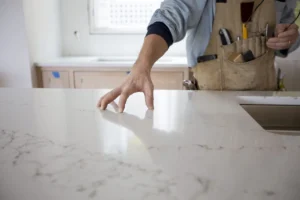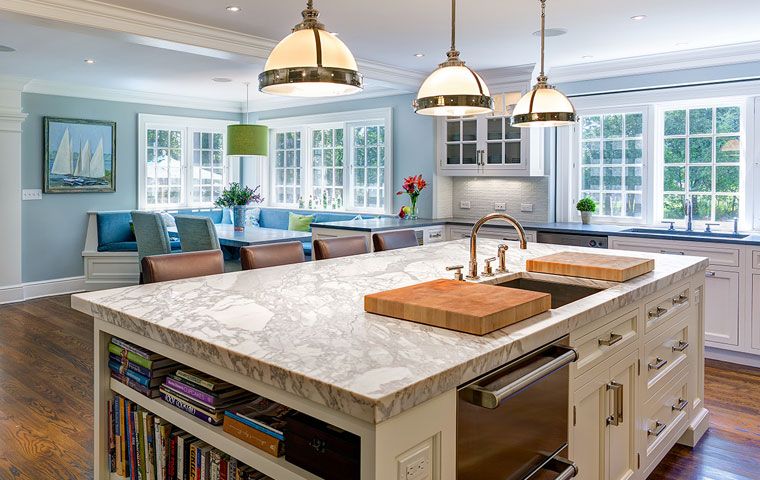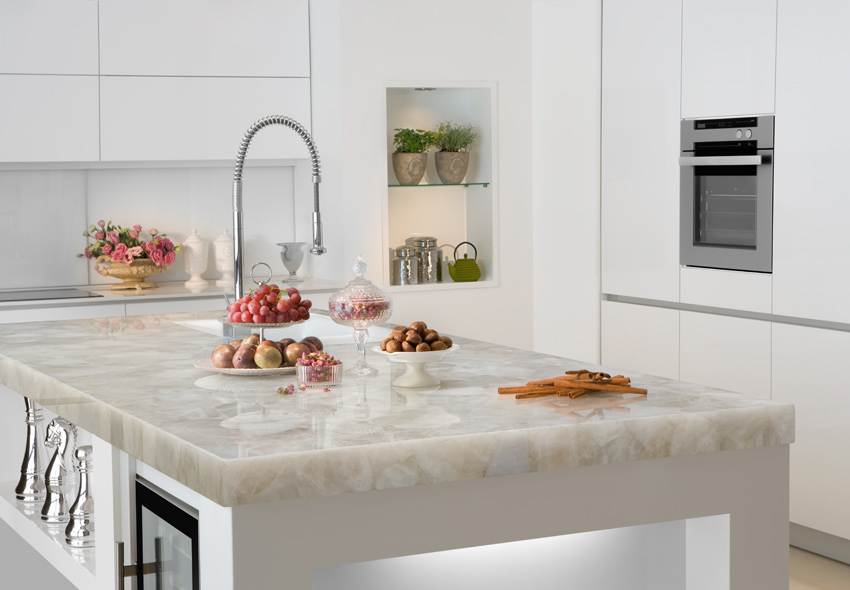Table of Contents
- The Quick Verdict
- Why Quartz Leaves the Factory “Already Sealed”
- What Happens If Quartz Countertops Are Not Sealed?
- What Happens If You Do Apply a Sealer?
- The True Purpose of Countertop Sealing
- Chemicals That Can Harm Quartz
- How to Protect Quartz’s Built-In Barrier
- Edge-Case Scenarios: When Extra Protection Might Help
- Frequently Asked Questions
- Key Takeaways
The Quick Verdict
No, standard residential quartz countertops never need to be sealed.
During manufacturing, crushed quartz, pigments, and resin are compressed under vacuum and cured into a non-porous slab. Brands such as Cambria state plainly that their products “never require sealing, polishing, or reconditioning.
Because liquids cannot penetrate the finished surface, aftermarket sealers add no real benefit and may actually dull the finish or void the warranty.
Why Quartz Leaves the Factory “Already Sealed”
- Vacuum vibro-compression drives out air pockets while a 100-ton press fuses the mixture into a dense matrix.
- Polyester or epoxy binders occupy the microscopic gaps that make natural granite or marble absorbent.
- Thermal curing permanently hardens that binder, locking pigments and quartz crystals together.
The resulting water-absorption rate is roughly 0.01 %, far below the 0.5 % threshold that triggers sealing recommendations for natural stone.
What Happens If Quartz Countertops Are Not Sealed?
Absolutely nothing—provided you clean them properly. Quartz is already stain-resistant, so juice, coffee, or cooking oil will sit on the surface until you wipe it away. Routine care calls for nothing more than warm water and a mild dish soap.
What Happens If You Do Apply a Sealer?
| Side-Effect | Why It Occurs |
| Hazy film or streaks | Sealer can’t penetrate, so it cures on top, leaving residue that must be stripped. |
| Altered sheen | High-build acrylics can change a polished surface to an uneven satin. |
| Warranty risk | Many brands void coverage if unapproved chemicals are used. |
| Money wasted | Commercial stone sealers cost $40-$80 per quart with zero performance gain. |
The True Purpose of Countertop Sealing
Sealing is designed to block stains in porous materials (granite, marble, concrete). Because quartz is engineered to be non-absorbent, applying the same rule is like waxing a non-stick pan: unnecessary and potentially counter-productive.
Porosity Comparison
| Surface | Approx. Absorption Rate | Needs Sealer? |
| Marble | 0.4 – 1.0 % | Yes – annually |
| Granite | 0.2 – 0.5 % | Yes – every 1-3 yrs |
| Quartz | 0.01 % | No |
Chemicals That Can Harm Quartz
Quartz resists stains, but some cleaners attack its resin binder and discolor the slab:
- High-pH bleach or alkaline degreasers cause yellowing over time.
- Ammonia-based glass sprays may leave cloudy spots.
- Drain openers or oven cleaners contain lye that can etch the surface.
- Strong solvents (acetone, paint thinner) – soften resin and dull shine.
How to Protect Quartz’s Built-In Barrier
- Daily wipe-down: Warm water + pH-neutral soap and microfiber cloth.
- Blot spills quickly – Pigments can cling to residue left on top.
- Use trivets – Resins tolerate up to ~150 °C; hotter pans can scorch.
- Cutting boards – Quartz blunts knives, while metal marks can transfer.
- Stick to manufacturer-approved sprays – Most list pH 6-8 cleaners or simple isopropyl alcohol.
Pro tip: For dried gunk, a plastic scraper followed by a 50/50 isopropyl-water spritz lifts residue without abrasion.
Edge-Case Scenarios: When Extra Protection Might Help
Outdoor Kitchens
UV rays can fade some resins; specialty UV-stable quartz lines or a penetrating UV blocker approved by the manufacturer may provide added insurance.
High-Traffic Commercial Service Lines
Restaurants that skid hot pans and caustic cleaners across prep stations might apply a sacrificial clear film (similar to phone-screen protectors) rather than a sealer that alters chemistry.
Dark, Matte Finishes
Ultra-matte surfaces can show oily fingerprints more than polished quartz. A food-safe conditioner formulated for engineered stone can reduce smudging without clogging pores. Always test on a sample off-cut first.
Frequently Asked Questions
Does food acid (lemon, vinegar) etch quartz the way it etches marble?
No. Acids can’t dissolve quartz’s resin matrix; they simply sit on top until wiped.
Can I use Clorox wipes?
Occasional use is unlikely to harm the surface, but daily bleach exposure may fade pigment. Stick to mild soap and water for routine cleaning.
Will sealing help hide micro-scratches?
Sealant is transparent and does not fill surface abrasions. Light buffing with a non-abrasive pad designed for quartz is more effective.
How do I restore the shine if someone mistakenly sealed the counter?
Use a stone-sealer stripper (per the label) followed by a gentle quartz polish; then rinse thoroughly. Severe haze may require professional resurfacing.
Key Takeaways
- Quartz countertops are engineered to be non-porous, so they ship with a permanent, factory-cured barrier that blocks stains.
- Adding sealer offers no benefit and can leave a sticky film, change gloss, or even void your brand warranty.
- The best “sealant” for quartz is proper daily care: mild soap, soft cloth, and immediate spill removal.
- Bleach, alkaline degreasers, and strong solvents are the real threats—avoid them to keep pigment bright.
- In niche cases (outdoor bars, commercial prep lines) ask the manufacturer about UV-stable grades or specialty protective films rather than traditional sealers.
By understanding why quartz is different from natural stone, you can skip unnecessary maintenance steps, save money, and keep your countertop looking showroom-fresh for decades.


